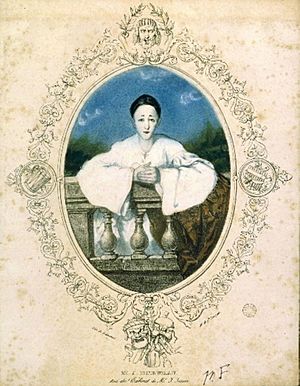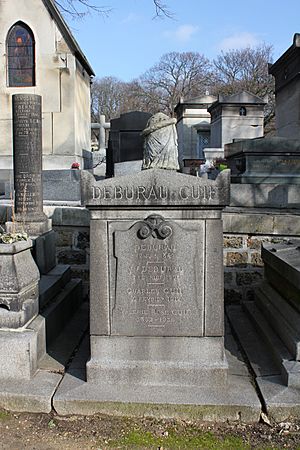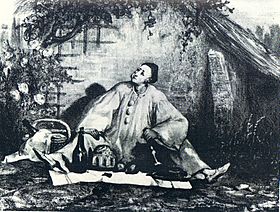Jean-Gaspard Deburau facts for kids
Jean-Gaspard Deburau (born Jan Kašpar Dvořák; July 31, 1796 – June 17, 1846) was a famous mime artist from Bohemia (now the Czech Republic) who became well-known in France. He performed for many years at a theater called the Théâtre des Funambules. This theater became famous in the movie Children of Paradise (1945), where Deburau is shown as a main character named "Baptiste."
Deburau's most famous role was Pierrot. This character became a big inspiration for many other Pierrots in art and theater, from the Romantic period to modern times.
Contents
Life and Career
Jean-Gaspard Deburau was born in Kolín, Bohemia (which is now part of the Czech Republic). His mother was Czech, and his father was a French soldier who later became a showman. His father led a traveling group of performers.
In 1814, his family's group moved to Paris. In 1816, they were hired to perform at the Funambules theater.
Deburau started playing the character of Pierrot right away. By 1825, he was the only actor playing this role at the theater. He became quite famous in 1828 when a well-known writer named Charles Nodier wrote great things about him. Another journalist, Jules Janin, wrote a book praising him in 1832. By the mid-1830s, Deburau was very well-known. Famous writers like Théophile Gautier, Théodore de Banville, and Charles Baudelaire all admired his acting talent.
In 1832, Deburau tried performing his pantomime at a different theater, the Palais-Royal, but it did not go well. The audience did not like it, and Deburau decided he would only perform for the loyal fans at the Boulevard du Crime theaters, like the Funambules.
After Deburau passed away, his son, Jean-Charles (1829–1873), took over his famous role. Jean-Charles later started a "school" for pantomime, which became popular in southern France and later in Paris.
Jean-Gaspard Deburau is buried in the Père Lachaise Cemetery in Paris.
Pantomime
Character Roles and Pierrot
While Pierrot was his most famous creation, Deburau played other characters too. These characters often had some similarities to Pierrot, much like how all of Charlie Chaplin's characters shared traits with his "Little Tramp" role. In Paris after the French Revolution, Deburau and Pierrot were almost the same in people's minds.
Deburau's Pierrot was very active and acrobatic. He was also very clever. Deburau made Pierrot less rough and more intelligent. One theater historian, Edward Nye, wrote that Pierrot "intellectually matured."
Deburau also changed Pierrot's costume to help his acting. He wore a large cotton blouse and trousers, which allowed him to move freely. He also removed the frilly collar and hat, which helped people focus on his expressive face. He wore only a simple black skullcap.
His biggest changes were in the pantomime performances themselves. While some thought his shows were all similar, Deburau actually created different kinds of Pierrot characters for different types of stories. He loved his art very much.
Here are some of the main types of pantomime he performed:
- The Rustic Pantomime: These stories were set in villages. Pierrot was a good-hearted but simple hero who would bravely overcome challenges to win the girl he loved.
- The Melo-Pantomime: These were exciting, dramatic stories set in faraway places like Africa or China. Pierrot was often a soldier or helper who used his cleverness to help the hero in thrilling adventures.
- The Realistic Pantomime: These shows took place in everyday city settings like shops or streets. In these, Pierrot was sometimes a bit mischievous or tricky, but still the main focus.
- The Pantomimic Fairy-Play: These were the grandest and most popular shows. They were set in magical fairylands with sorcerers, giants, and fairies. Pierrot often went on quests to achieve a goal or prove himself.
- Pierrot-focused Fairy-Play: In these, Pierrot was usually the only main character from the traditional Commedia Dell'Arte. The stories were wild and funny.
- Harlequin-focused Fairy-Play: These shows, still performed today in places like Bakken in Denmark, featured Harlequin as the lover who runs off with Columbine, while Pierrot and her father chase them.
- English Style Fairy-Play: These started with two suitors wanting the same lady, and a fairy would appear to help the more deserving one (Harlequin) and change the characters into Commedia types, leading to a chase.
Myths About Deburau
The People's Pierrot
Many people today know Deburau from the movie Children of Paradise. In the film, he is shown as a simple man of the people, a sad lover, and a friend of the moon. However, the real Deburau and his Pierrot were not exactly like this. This idea came from clever writers and romantic stories. After Deburau died, writer George Sand noted that the street kids of Paris saw Pierrot as their "model."
The Tragic Pierrot
In 1842, a pantomime was performed where Pierrot died at the end. This was very unusual for Deburau's theater. It was like if Charlie Chaplin's Little Tramp character died at the end of a movie! This sad ending was actually created by the poet Théophile Gautier in a review he wrote. The theater managers decided to turn his review into a show. It was not very successful and was not performed again at the Funambules.
However, Gautier's story of the tragic Pierrot lived on. Later writers and filmmakers, like Sacha Guitry and Marcel Carné (for Children of Paradise), used this idea of a tragic Pierrot in their own works.
The Moonstruck Pierrot
Deburau's fans often connected Pierrot with the moon. Poet Théodore de Banville wrote a poem in 1842 where the moon "peeps behind the scenes" at Deburau. As time went on, this connection grew stronger. A book of poems called Pierrot lunaire (1884) by Albert Giraud and a famous music piece by Arnold Schoenberg (1912) further linked Pierrot to the moon and a sense of madness.
See also
 In Spanish: Jean-Gaspard Deburau para niños
In Spanish: Jean-Gaspard Deburau para niños





